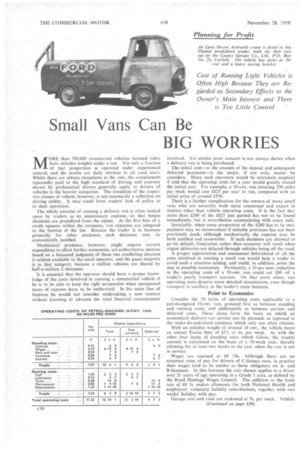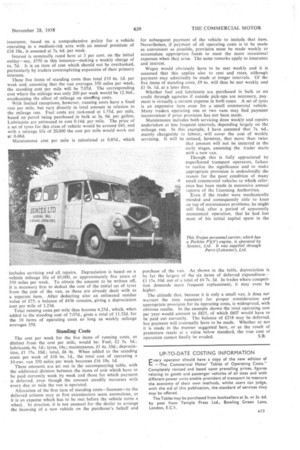Small Vans Can Be
Page 68

Page 71

If you've noticed an error in this article please click here to report it so we can fix it.
BIG WORRIES
MORE than 500,000 commercial vehicles licensed today have unladen weights under a.ton, Yet only a fraction of that proportion ia operated under experienced control, and the results are daily obvious to all road users. Whilst there are always exceptions to the rule, the compliments repeatedly paid to the high standard of driving and courtesy shown by professional drivers generally apply to drivers ofvehicles in the heavier categories. The condition of the respec-. tive classes of vehicle, however, is not necessarily a reflection on driving ability. It may result from traders' lack of policy as to their operation.
The whole exercise of running a delivery van is often looked upon by traders as an unnecessary expense,,' so that future decisions are prejudiced from the outset. At the first hint of a .credit squeeze within the company, van expenses are relegated to the bottom of the list. Because the trader is in business primarily forother purposes, such decisions may be
economically justified. . .
Mechanical prudence, however, might require current expenditure to effect further economies, yet authoritative opinion based on a balanced judgment of these two conflicting interests is seldom available to the small operator, and the great majority is in that category, because a million vehicles are shared by half-a-million C-licensees. .
It is essential that the operator should have a proper knowledge of the costs involved in running a commercial vehicle if he is to be able to keep the right perspective when unexpected items of expense have to be authorized. In his main line, of business he would not consider undertaking a new venture without knowing in advance the total financial commitments involved. Yet similar prior concern is not always shown when a delivery van is being purchased.
The initial cost—or the amount of the deposit and subsequent deferred payments—is the major, if not only, matter he considers. Many such operators would be extremely sceptical if told that the operating costs for a year would greatly exceed the initial cost. For example, a 10-cwt. van covering 350 miles per week would cost £825 per year to run, compared with an initial price of around £550.
There is a further complication for the owners of many small vans who are naturally both more concerned and expert in matters other than vehicle operating costs. It is the fact that more than £200 of the £825 just quoted has not to be found immediately, but is nevertheless accumulating with every mile.
Invariably, when some proportion of the £200 has to be met, payment may be inconvenient if suitable provision has not been previously made, although mechanically the expense may be both justified and reasonable. If such decisions are allowed to go by default, frustration rather than economy will result when urgent deliveries are delayed through vehicles being off the road.
A proper appreciation and assessment beforehand of all the costs involved in running a small van would help a trader to avoid such a situation arising, and could, in addition, point the way to possible economies. Pertinently, a 10 per cent, reduction in the operating costs of a 10-cwt. van could cut £80 off a trader's yearly transport account. On that score alone, van operating costs deserve more detailed examination, even though transport is ancillary to the trader's main business.
Point to Economies
Consider the 10 items of operating costs applicable to a petrol-engined 10-cwt. van, grouped first as between standing and running costs, and additionally as between current and deferred costs. These alone form the basis on which an economical delivery-van service can be planned, as opposed to the make-do-and-mend existence which only too often obtains.
With an unladen weight of around 18 cwt., the vehicle bears an annual Excise duty of £15, or 6s. per week. As with the other four items of standing costs which follow, the weekly amount is calculated on the basis of a 50-week year, thereby allowing for at least two weeks in the year when the van is not in service.
Wages are assessed at £8 19s. Although there are no statutory rates of pay for drivers of C-licence vans, in practice their wages tend to be similar to those obligatory on Aand B-licensees. In this instance the rate chosen applies to a driver over 21 years of age operating in a Grade 1 area, as defined by the Road Haulage Wages Council. The addition to the basic rate of 18 3s. makes allowance for both National Health and employers' voluntary liability contributions, together with two weeks' holiday with pay.
Garage rent and rates are reckoned at 7s. per week. Vehicle (Continued on page 639) insurance, based on a comprehensive policy for a. vehicle operating in a medium-risk area with an annual premium of £18 10s., is assessed at 7s. 6d. per week.
Interest is nominally rated here at 3 per cent, on the initial outlay—say, £550 in this instance—making a weekly charge of 6s. 7d. It is an item of cost which should not be overlooked, particularly by traders contemplating expansion of their primary interests.
These five items of standing costs thus total £10 6s. ld. per week and, assuming that the van averages 350 miles per week, the standing cost per mile will be 7.07d, The corresponding cost where the mileage was only 200 per week would be 12.36d., emphasizing the effect of mileage on stantting costs.
With limited exceptions, however, running costs have a fixed rate per mile, but vary directly, in total amount in relation to the mileage run. .Fuel costs are .reckoned at 1.55d. per mile, based on petrol. being purchased in bulk at 3s. 9d, per -gallon. Lubricants are estimated to cost 0.14d. per mile. The price of a set of tyres for this class of vehicle would be around £40, and with a mileage life of 20,000 the cost per mile would work out at 0.48d.
Maintenance cost per -mile is calculated at 0.85d., which includes servicing and all repairs. Depreciation is based on a vehicle mileage life of 85,000, or approximately five years at 350 miles per week. To obtain the amount to be written off, it is necessary first to deduct the cost of the initial set of tyres from the cost of the van, as these are already dealt with as a separate item. After deducting also an estimated residue value of £75, a balance of £436 remains, giving a depreciation cost per mile of 1.23d.
Total running costs per mile thus become 4.25d., which, when added to the standing cost of 7.07d., gives a total of 11.32d. for the 10 items of operating costs so long as weekly mileage averages 350.
Standing Casts
The cost per week for the five items of running costs, as distinct from the cost per mile, would be: Fuel, £2 5s. 3d.; lubricants, 4s. ld.; tyres, 14s.; maintenance, £1 4s. 10d.; depreciation, £1 15s. 10d.; total, £6 4s. When added to the standing costs per week of £10 6s. Id., the total cost of operating a 10-cwt. van 350 miles per week becomes £16 10s. Id.
These amounts are set out in the accompanying table, with the additional division between the items of cost which have to be paid currently week by week and those for which payment is deferred, even though the amount steadily increases with every day or mile the van is operated.
Allocation of the first item of standing costs—licences—to the deferred column may at first examination seem anomalous, as it is an expense which has to be met before the vehicle turns a wheel. In practice, it is not unusual for the dealer to arrange the licensing of a new vehicle on the purchaser's behalf and for subsequent payment of the vehicle to include that item_ Nevertheless, if payment of all operating costs is to be made as convenient as possible, provision must be made weekly to accumulate appropriate funds to meet the more occasional expenses when they arise. The same remarks apply to insurance and interest.
Wages would obviously have to be met weekly and it is assumed that this applies also to rent and rates, although payment may admittedly be made at longer intervals. Of the five items of standing costs, £9 6s. will thus be met weekly and £1 Os. ld, at a later date.
Whether fuel and lubricants are purchased in bulk or on credit through agencies if outside pick-ups are necessary, payment is virtually a current expense in both cases. A set of tyres is an expensive item even for a small commercial vehicle. Many traders operating one or two vans may find payment inconvenient if prior provision has not been made.
Maintenance includes both servicing done weekly and repairs undertaken at less frequent intervals, depending largely on the mileage run. In this example, I have assumed that 7s. 6d., mainly chargeable to labour, will cover the cost of weekly servicing. It will be noticed, however, that more than twice that amount will not be incurred in the early stages, assuming the trader starts with a new van.
Though this is fully appreciated by experienced transport operators, failure to realize the significance and to make appropriate provision is undoubtedly the reason for the poor condition of many small Commercial vehicles to which reference has been made in successive annual reports of the Licensing Authorities.
Even if the trader were mechanically minded and consequently able to keep on top of maintenance problems, he might still find, after a period of apparently economical operation, that he had lost most of his initial capital spent in the purchase of the van. As shown in the table, depreciation is by far the largest of the six items of deferred expenditure— £1 15s. 10d. out of a total of £4 7s. 3d. In trades where competition demands more frequent replacement, it may even be higher.
The attitude that, because it is only a small van, it does not warrant the time necessary for proper consideration and appropriate provision for its operating costs, is widespread, with obvious results. In the example shown the total operating cost per year would amount to £825, of which £607 would have to be paid out currently. The balance of £218 may be deferred, but payment will eventually have to be made. Whether or not it is made in the manner suggested here, or as the result of premature resale at a value below standard, the true cost of operation cannot finally be evaded. S.B.












































































































